Motor Control using PWM and PID
Bi-directional motor control is can be done using an H-bridge circuit with pulse-width
modulation (PWM) from a microcontroller to vary the speed. Several design
challenges include preventing shoot-through, implementing a snubber circuit, as well
as open and closed loop (such as PID) control mechanisms.
PWM Control of an H-Bridge
An H-bridge circuit consists of four transistors (usually two PMOS's and two
NMOS's). To maximize efficiency, the transistors are driven at a higher voltage than
the microcontroller. A typical H-bridge circuit with logic scaling circuitry is shown
above.
Each side of the H-bridge has two transistors with the gates tied together resulting in
complementary operation--Q3 is always off when Q1 is on and vice versa. The same
is true for Q2 and Q4. The circuit works by setting PWMB to logic zero (Q2 on; Q4
off) and then setting PWMA to logic high (Q1 off; Q3 on). The motor direction can
be reversed by toggling PWMA and PWMB.
PWM is a simple way to vary the voltage applied to the motor. Most microcontrollers
have dedicated PWM hardware, but an output compare timer can also generate a
PWM signal. PWM works by rapidly turning the motor on and off. For example, if
the motor supply is 12V, the motor can be driven at 6V by applying a 50% duty cycle
where half the time 12V is applied, and half the time 0V is applied as shown by the
green signal in the plot below.
�
While using PWM is simple, it introduces a problem called shoot-through which
occurs when current flows directly from the power supply to ground when the
transistors are being switched. For example, when the PWMA input signal switches
from high to low, Q1 turns on and Q3 turns off. For a brief period of time, both Q1
and Q3 are partially on allowing current to flow from the supply to ground. This
causes efficiency to plummet and introduces heating problems in the transistors. To
overcome this problem additional circuitry must be added to ensure Q3 turns
completely off before Q1 starts to turn on.
Preventing Shoot-through
The easiest way to implement a shoot-through prevention circuit is to use an
integrated circuit (IC) that has shoot-through protection built-in. The Si9986 IC from
Vishay is an H-bridge motor driver circuit with built-in shoot-through protection as
well as logic translation circuitry (Q5A and Q5B in the diagram above). It is a great
solution for controlling a small DC motor using a PWM signal from a
microcontroller. When using the Si9986, as with using any motor driver, a snubber
circuit is required to reduce electromagnetic noise in the system.
A Snubber Circuit to Decrease Noise
A snubber circuit is used to suppress the voltage transients caused by PWM switching
(as well as by the inherent switching in brushed motors). A DC motor is an inductive
load; the voltage across which is proportional to the change in current, given by:
�
When the PWM signal switches the motor from on to off, there is a rapid change in
is large) which causes a voltage spike. Without a snubber circuit, the
current (i.e.
energy from the voltage spike can result in arcing, damage to the body diode in the H-
bridge transistors, or cause electromagnetic interference in nearby circuitry. The
snubber circuit safely dissipates the energy in passive elements. A simple, effective
snubber circuit consists of a resistor and capacitor in series across the terminals of the
motor as shown below.
PID Control
With an H-bridge, a pair of PWM signals, and a snubber circuit, the motor is ready for
bi-directional control. The simplest form of control is open loop. This means the
controller simply applies a voltage (a PWM signal in this case) but has no way to
measure the effect of the applied voltage. The controller simply assumes higher
voltage makes the motor go faster. Closed loop control uses feedback from the motor,
such as the motor current or speed, to adjust the PWM signal.
A PID loop--verbosely known as proportional, integral, differential loop--is a popular
algorithm in many closed loop systems.
Image from Wikipedia
�
The diagram above represents a PID controlled process. In this case, the "process" or
"plant" is the motor. The feedback mechanism--y(t) called the process variable--can
be either the motor current or speed. The set point, u(t), is the desired current or
speed. The PID loop takes the difference (or error), e(t), between the set point and the
process variable, applies namesake adjustments--proportional, integral, as well as
differential--and then sums the result to get the new value of the manipulated variable
(the PWM duty cycle).
The following code is a PID loop implementation using floating point variables. The
structure (pid_f_t) is first initialized using pid_init_f() with the minimum and
maximum values for the manipulated variable accepted as parameters. The minimum
is useful if the motor requires some minimum PWM duty cycle to make it turn while
the maximum ensures the PID algorithm does not try to exceed 100% duty cycle. The
pid_update_f() function uses the current set point and the process variable as well as
the constants stored in the pid_f_t structure to compute the manipulated variable. The
application loop includes a function to measure the motor current or speed, call
pid_update_f(), and set the PWM value according to the manipulated variable.
typedef struct{
float max /*! Max manipulated value */;
float min /*! Miniumum manipulated value */;
float e /*! Error value */;
float i /*! Integrator value */;
float kp /*! Proportional constant */;
float ki /*! Integrator constant */;
float kd /*! Differential constant */;
} pid_f_t;
/*! \details This function initializes the data in a PID structure.
*
*/
void pid_init_f(pid_f_t * ptr /*! A pointer to the PID data structure
*/,
float min /*! The manipulated variable's minimum value */,
float max /*! The manipulated variable's maximum value */){
memset(ptr, 0, sizeof(pid_f_t));
ptr->min = min;
ptr->max = max;
}
/*! \details This function updates the value of the manipulated
variable (MV)
* based on the current state of the PID loop.
*/
float pid_update_f(float sp /*! The set point */,
float pv /*! The process variable */,
pid_f_t * ptr /*! A pointer to the PID constants */){
float temp;
float e;
float p;
float manp;
float tmpi;
e = ptr->e;
ptr->e = sp - pv;
tmpi = ptr->i + ptr->e;
//bound the integral
manp = ptr->kp * ptr->e + ptr->ki * tmpi + ptr->kd * (e - ptr->e);
�
ptr->i = tmpi;
manp = ptr->max;
manp = ptr->min;
if ( (manp < ptr->max) && (manp > ptr->min) ){
} else if ( manp > ptr->max ){
} else if ( manp < ptr->min ){
}
return manp;
}
It is important to properly apply the manipulated variable to the process. In the H-
bridge shown above, Q5 inverts the PWM signal which means the software needs to
invert the PWM value before applying it. Also while switching Q2 and Q4, the states
of Q1 and Q3 determine the motor direction; this affects how the sign of the
manipulated variable is interpreted. These nuances in the circuit can make debugging
a PID loop tricky but can be overcome with sound analysis as well as trial and error.
Example
Here is an example circuit and code using the Laertes Lite Microcomputer running
CoActionOS, a 12V DC motor connected to a rotary encoder, and the Si9986 H-
Bridge driver chip. The image below shows the breadboard setup.
Hardware Setup
The parts include:
Laertes Lite Microcomputer
�
SMT to DIP Adapter and Si89986 H-Bridge PWM Driver
Generic 12V DC Brushed Motor
Rotary Motor Encoder (200 counts per revolution from Sparkfun Electronics)
10K Potentiometer (used for user input)
The following drawing shows the specific connections. The user input (to set the
speed) consists of a potentiometer wiper connected to P0.2 (ADC Channel 7). The
rotary encoder is connected to P1.26 which also serves as a clock input for timer zero.
Finally, 2.3 and 2.4 are PWM outputs connected to the input of the Si9986 H-bridge
driver. For more details, please see the Laertes-Lite page where the schematic and
datasheet are available.
Source Code
The source code uses a PID loop to control the motor speed. First, it reads the ADC to
calculate a speed setting from 1500RPM to 10,000RPM which is set by the user using
the potentiometer. After the ADC is sampled, it is filtered using an exponential
moving average, low-pass filter. This prevents noise on the ADC from causing
changes to the speed setting. The code then calculates the motor speed in revolutions
per minute. It measures the rising edges of the rotary encoder (200 counts per
revolution) using the timer clock input. It then uses the POSIX function (provided by
CoActionOS) clock_gettime() to calculate the change in time since the last
measurement. The current speed is then the change in number of revolutions divided
by the change in time. The current speed and the set point speed are then passed to the
PID calculation which returns the duty cycle which is applied to the PWM output.
The CoActionOS application shown below uses eLib for the EMA filtering and PID
loop calculations. It relies on CoActionOS-Applib to access peripheral hardware. To
view the code for these functions, please see the source code download page.
#include
#include
#include
#include
�#include
#include
#include
#define TMR_PORT 0 //Timer port used to capture encoder data
#define ADC_PORT 0 //ADC port for getting user input
#define ADC_INPUT_CHAN (7) //ADC channel for user input
#define PWM_PORT 1 //PWM port for Si9986
#define PWM_CHAN_HIGH (PWM_CHANNEL5)
#define PWM_CHAN_LOW (PWM_CHANNEL4)
#define PWM_FREQ (1000000)
#define PWM_TOP 1000 //Top value for PWM clock
#define PWM_PERIOD (PWM_TOP*1000/PWM_FREQ) //Period in ms
static int init(void); //initilize timer, PWM and ADC
static int init_tmr(void);
static int init_pwm(void);
static int init_adc(void);
//Set the output duty cycle
static void set_duty(int duty);
int main(int argc, char * argv[]){
//PWM clock frequency
pwm_reqattr_t req;
int i;
//These are for sampling the ADC (user input)
adc_sample_t samp;
int32_t samp_avg;
uint16_t alpha;
uint32_t set_speed;
//This is for measuring the motor speed
uint32_t delta_ms; //elapsed time in milliseconds
uint32_t last_ms;
uint32_t now_ms;
uint32_t ref_ms;
struct timespec now;
uint32_t current_pos; //current position
uint32_t last_pos; //position from last measurement
uint32_t delta_pos;
uint32_t speed;
//PID variables
pid_i32_t pid;
uint32_t duty;
if( init() < 0 ){
bogus
last_ms = 0;
//exit unsuccessfully if any hardware failed to
initialize
exit(1);
}
//Initialize the ADC averaging (EMA filter)
alpha = DSP_EMA_I32_ALPHA(0.1);
adc_read(ADC_PORT, ADC_INPUT_CHAN, &samp, sizeof(adc_sample_t));
samp_avg = samp;
//Since there is no initial measurement, the first speed will be
�//initialize the PID
pid_init_i32(&pid, 200, 900); //Bound the duty between 20% and 90%
pid_setconstants_i32(&pid,
//These constants take some tweaking to get
everything to work smoothly
PID_I32_CONSTANT(0.05), //P constant
PID_I32_CONSTANT(0.01), //I constant
PID_I32_CONSTANT(0.0001)
);
//D constant
usleep(50*1000);
set_duty(0);
//Get the initial time so that the program start time is close to
zero in the output data
clock_gettime(CLOCK_REALTIME, &now);
ref_ms = (now.tv_sec * 1000 + (now.tv_nsec + 500000) / 1000000);
//convert to milliseconds
i = 0;
while(1){
//Read and averge the ADC to get the set point
adc_read(ADC_PORT, ADC_INPUT_CHAN, &samp, sizeof(adc_sample_t));
samp_avg = dsp_ema_i32(samp, samp_avg, alpha);
set_speed = samp_avg * 8500 / ADC_MAX + 1500;
//Now measure the position and calculate the speed (pos/time)
clock_gettime(CLOCK_REALTIME, &now);
now_ms = (now.tv_sec * 1000 + (now.tv_nsec + 500000) / 1000000);
delta_ms = now_ms - last_ms;
last_ms = now_ms;
//convert to milliseconds
current_pos = tmr_get(TMR_PORT);
delta_pos = current_pos - last_pos;
//calculate in RPM (1000*60 ms in a min and 200 counts per
revolution)
speed = (delta_pos*(1000*60/200))/(delta_ms);
last_pos = current_pos;
//Calculate the new duty cycle
duty = pid_update_i32(set_speed, speed, &pid);
set_duty(duty);
//Display the data and wait for the next update
if ( i++ > 0 ){ //first sample is garbage because the delta
printf("%d %d %d %d;\n", now_ms - ref_ms, set_speed, speed,
values are invalid
duty);
}
usleep(25*1000); //update every 25 ms
}
return 0;
}
int init(void){
if( init_tmr() < 0 ){ return -1; }
if( init_adc() < 0 ){ return -1; }
�
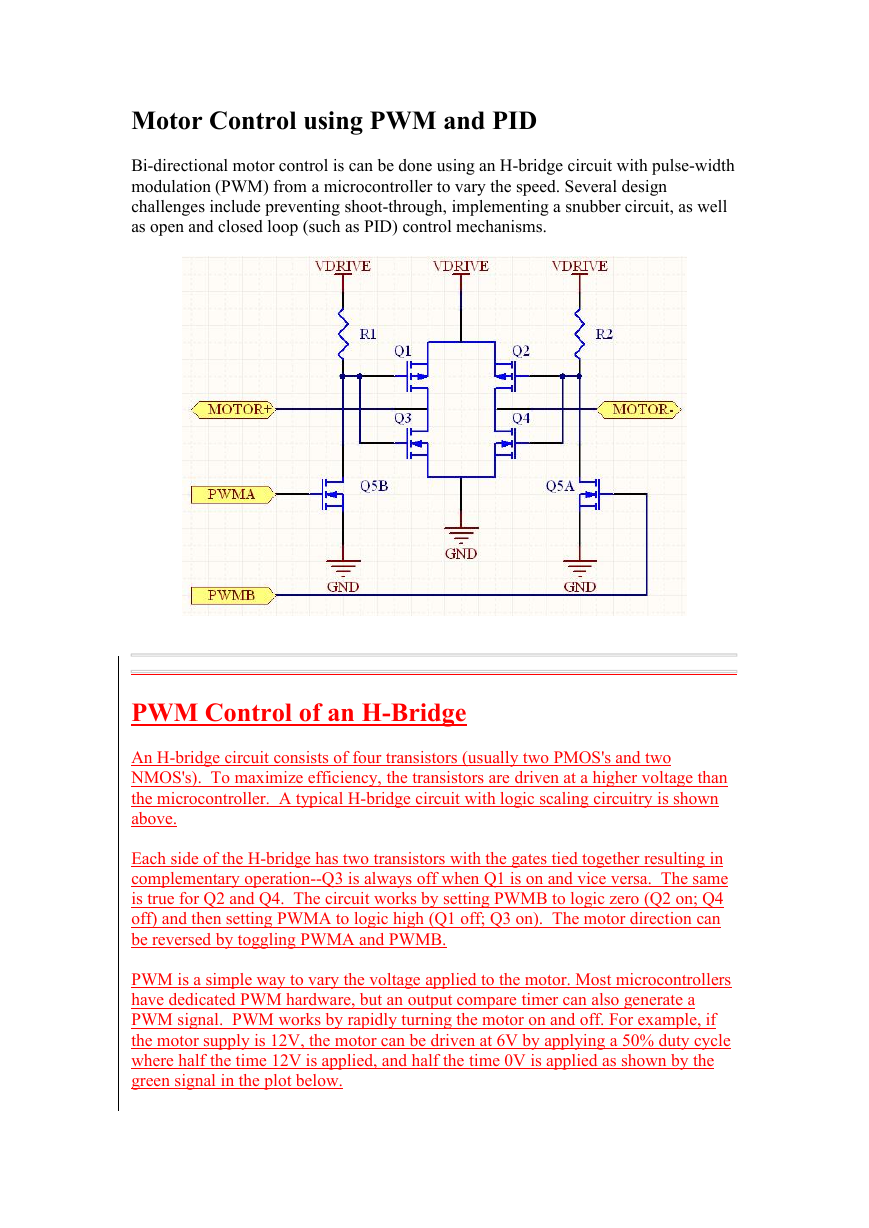
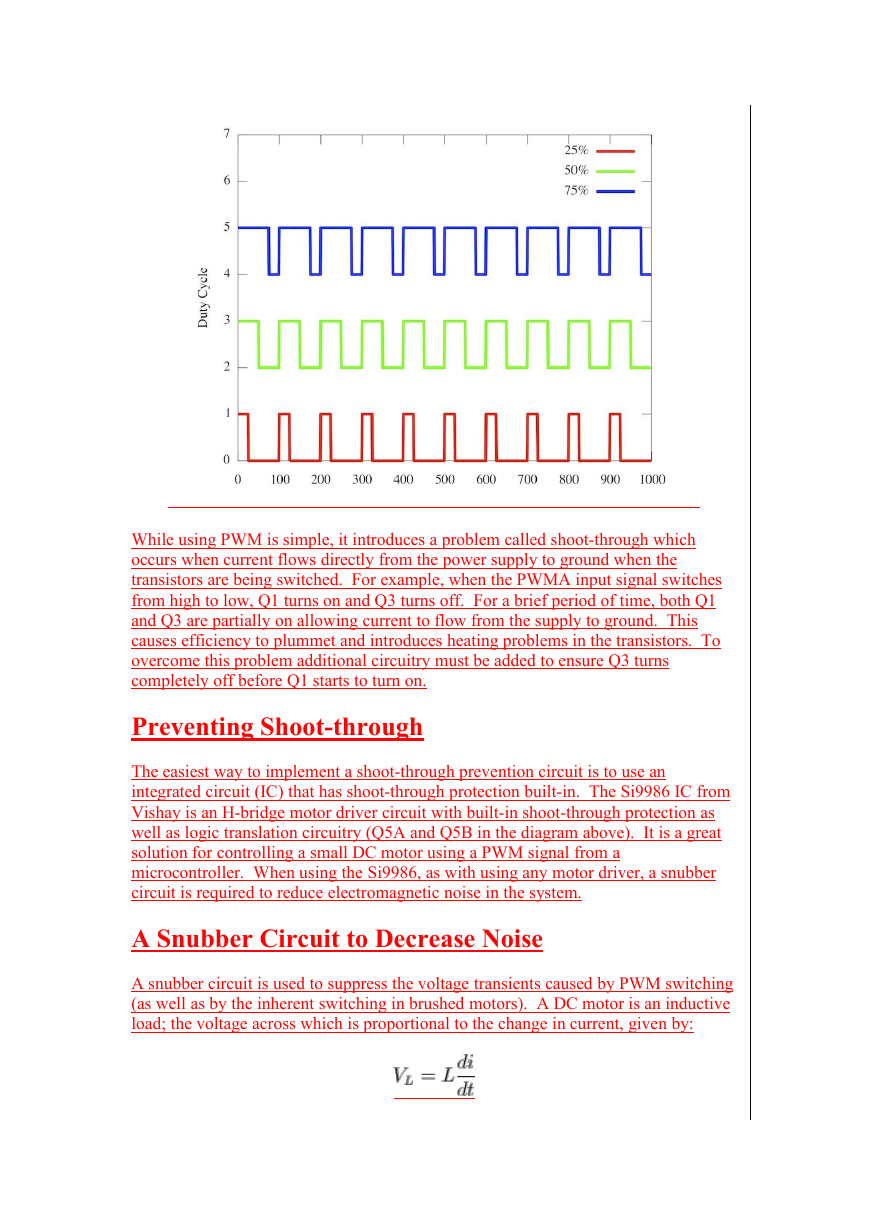
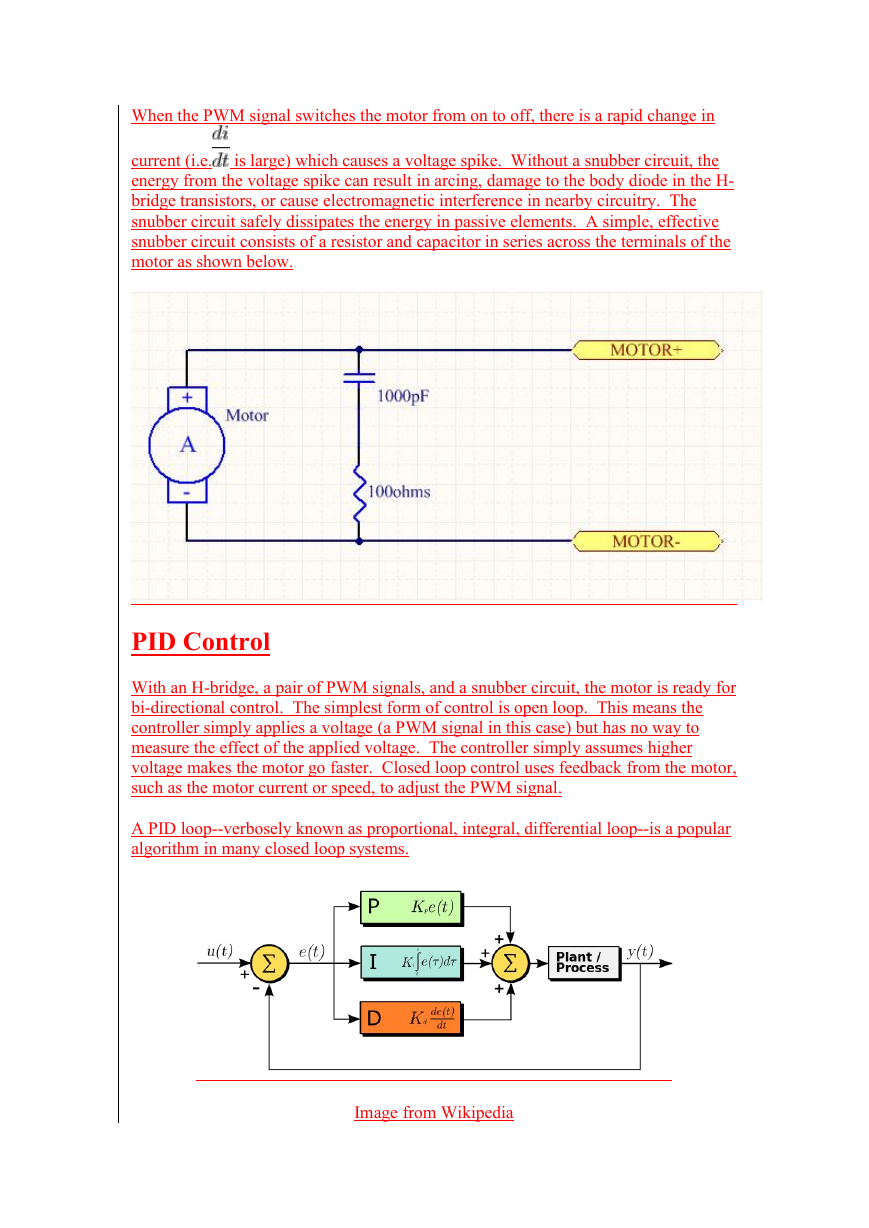

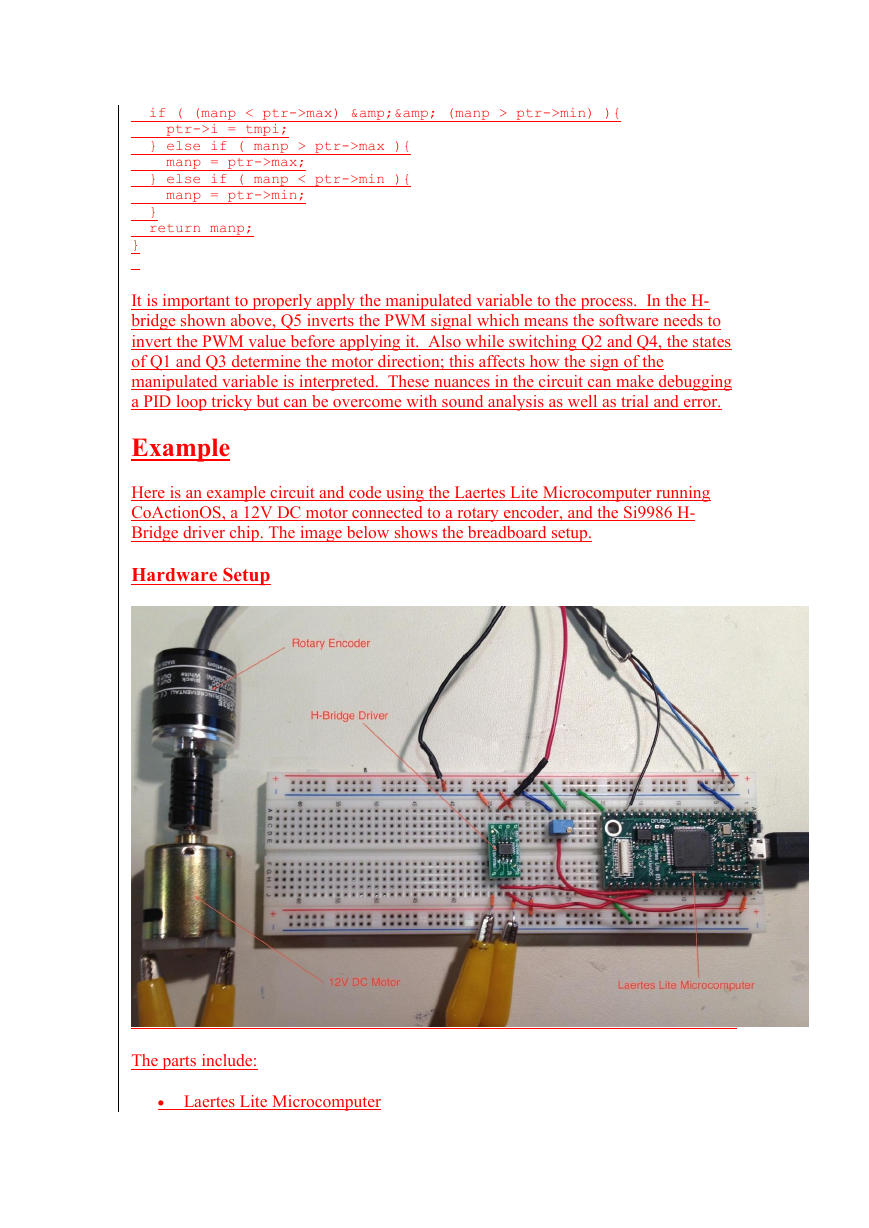
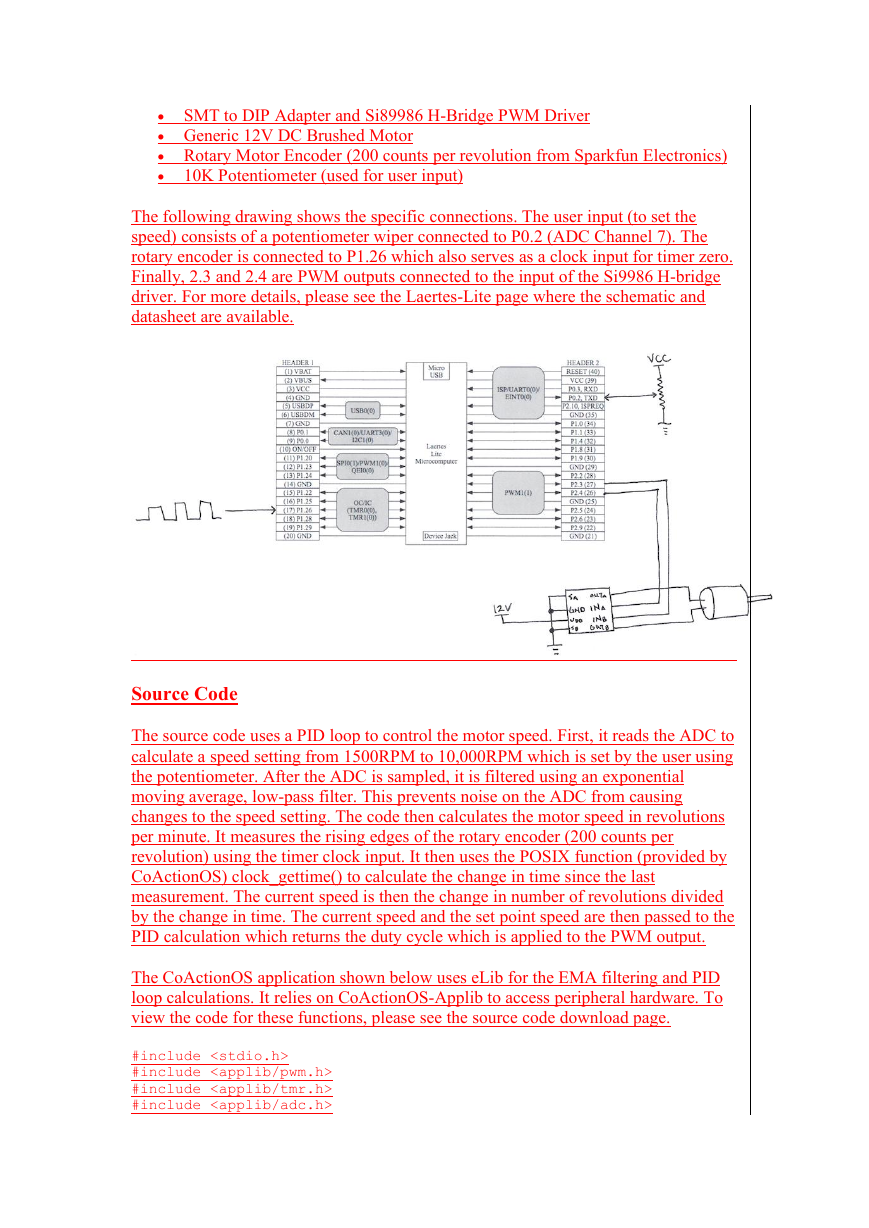
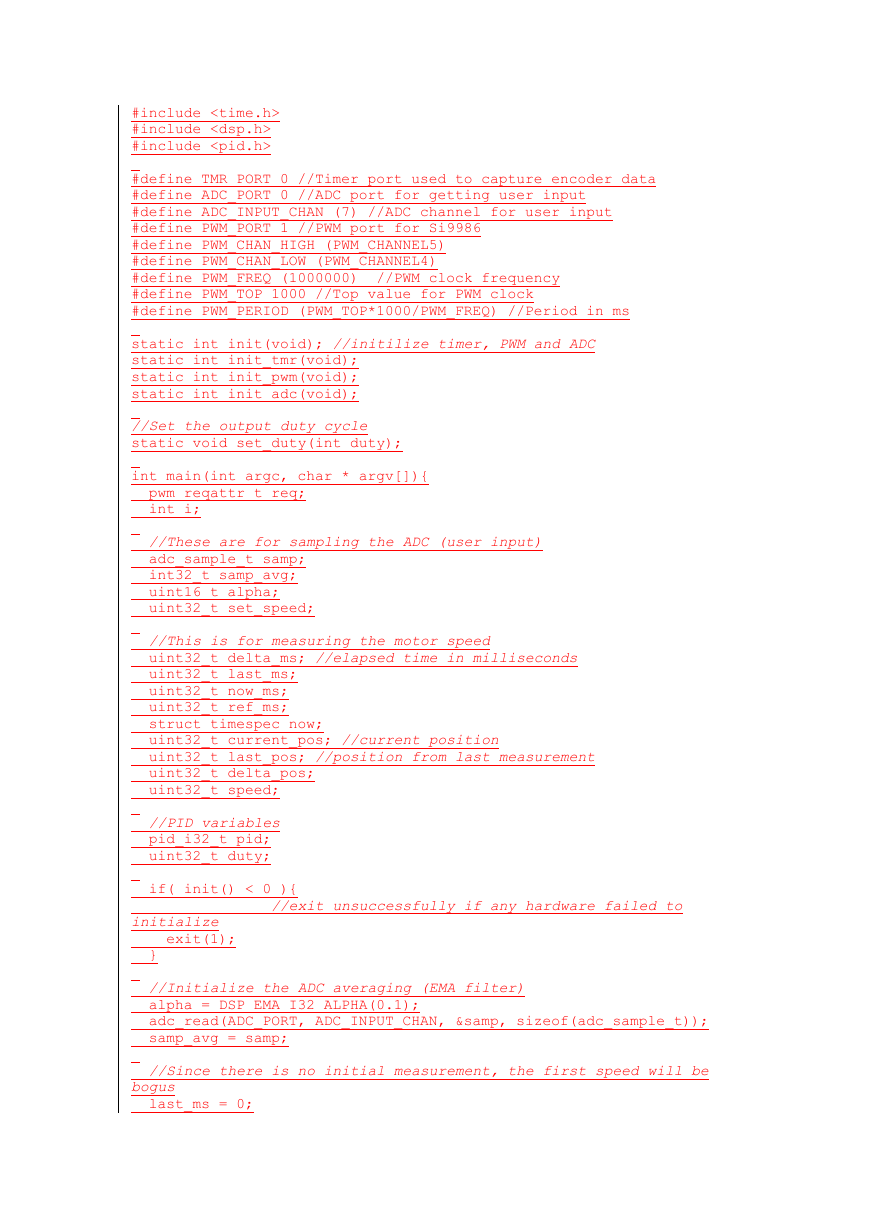









 2023年江西萍乡中考道德与法治真题及答案.doc
2023年江西萍乡中考道德与法治真题及答案.doc 2012年重庆南川中考生物真题及答案.doc
2012年重庆南川中考生物真题及答案.doc 2013年江西师范大学地理学综合及文艺理论基础考研真题.doc
2013年江西师范大学地理学综合及文艺理论基础考研真题.doc 2020年四川甘孜小升初语文真题及答案I卷.doc
2020年四川甘孜小升初语文真题及答案I卷.doc 2020年注册岩土工程师专业基础考试真题及答案.doc
2020年注册岩土工程师专业基础考试真题及答案.doc 2023-2024学年福建省厦门市九年级上学期数学月考试题及答案.doc
2023-2024学年福建省厦门市九年级上学期数学月考试题及答案.doc 2021-2022学年辽宁省沈阳市大东区九年级上学期语文期末试题及答案.doc
2021-2022学年辽宁省沈阳市大东区九年级上学期语文期末试题及答案.doc 2022-2023学年北京东城区初三第一学期物理期末试卷及答案.doc
2022-2023学年北京东城区初三第一学期物理期末试卷及答案.doc 2018上半年江西教师资格初中地理学科知识与教学能力真题及答案.doc
2018上半年江西教师资格初中地理学科知识与教学能力真题及答案.doc 2012年河北国家公务员申论考试真题及答案-省级.doc
2012年河北国家公务员申论考试真题及答案-省级.doc 2020-2021学年江苏省扬州市江都区邵樊片九年级上学期数学第一次质量检测试题及答案.doc
2020-2021学年江苏省扬州市江都区邵樊片九年级上学期数学第一次质量检测试题及答案.doc 2022下半年黑龙江教师资格证中学综合素质真题及答案.doc
2022下半年黑龙江教师资格证中学综合素质真题及答案.doc